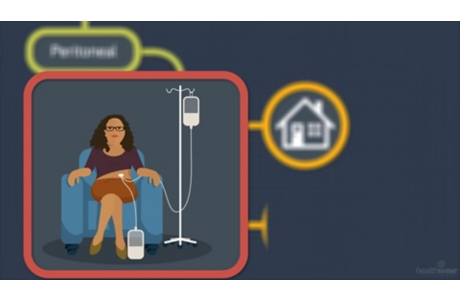peritoneal dialysis
treatment overview
peritoneal dialysis uses a membrane inside your body (peritoneal membrane) as a filter. it clears wastes and extra fluid from your body and works to return electrolyte levels to normal. unlike in-centre hemodialysis, you don't need to travel to a dialysis centre for your treatment. instead, after being trained at a dialysis centre, you will do your treatment at home on your own schedule. peritoneal dialysis can often be done at night, while you sleep.
you will need to have a catheter placed in your belly (dialysis access) before you start dialysis. placement is usually done 10 to 14 days before dialysis starts.
the process of doing peritoneal dialysis is called an exchange. you will usually complete 4 to 6 exchanges each day using these steps:
- fill: dialysis fluid enters your peritoneal cavity.
- dwell: while the fluid is in your peritoneal cavity, extra fluid and waste travel across the peritoneal membrane into the dialysis fluid.
- drain: after a few hours, the dialysis fluid is drained and replaced with new fluid.
there are different types of peritoneal dialysis:
- continuous ambulatory peritoneal dialysis (capd).
- you change the dialysis solution multiple times a day.
- continuous cycling peritoneal dialysis (ccpd).
- it takes 8 to 12 hours and can be done while you sleep.
discuss these treatment methods with your doctor to decide which one might work best for you.
things to consider
- peritoneal dialysis can be done at home or in any clean place. you may be able to do it while you sleep.
- you can do it by yourself. you don't have to rely on help from others.
- you can do it at the times you choose as long as you do the right number of treatments.
- it has to be done every day of the week.
- some people find it hard to do all the required steps.
- it increases your chance for a serious infection of the lining of the belly (peritoneum).
what to expect
you may have mild back pain during peritoneal dialysis. or you may feel like your abdomen is full.
why it is done
peritoneal dialysis replaces the work of the kidneys after complications of kidney failure develop.
how well it works
peritoneal dialysis (pd) does not fully replace normal kidney function. it does not reverse chronic kidney disease or kidney failure. pd only provides up to 10% of normal kidney function. for this reason, it's important to take your medicines as instructed and follow your eating plan.
risks
the most common complications from peritoneal dialysis include infection around the catheter site and infection of the lining of the abdominal wall (peritonitis). less often, there may be problems related to the catheter. but most complications can be managed or prevented.
credits
current as of: october 11, 2023
author: healthwise staff
clinical review board
all healthwise education is reviewed by a team that includes physicians, nurses, advanced practitioners, registered dieticians, and other healthcare professionals.
current as of: october 11, 2023
author: healthwise staff
clinical review board
all healthwise education is reviewed by a team that includes physicians, nurses, advanced practitioners, registered dieticians, and other healthcare professionals.

